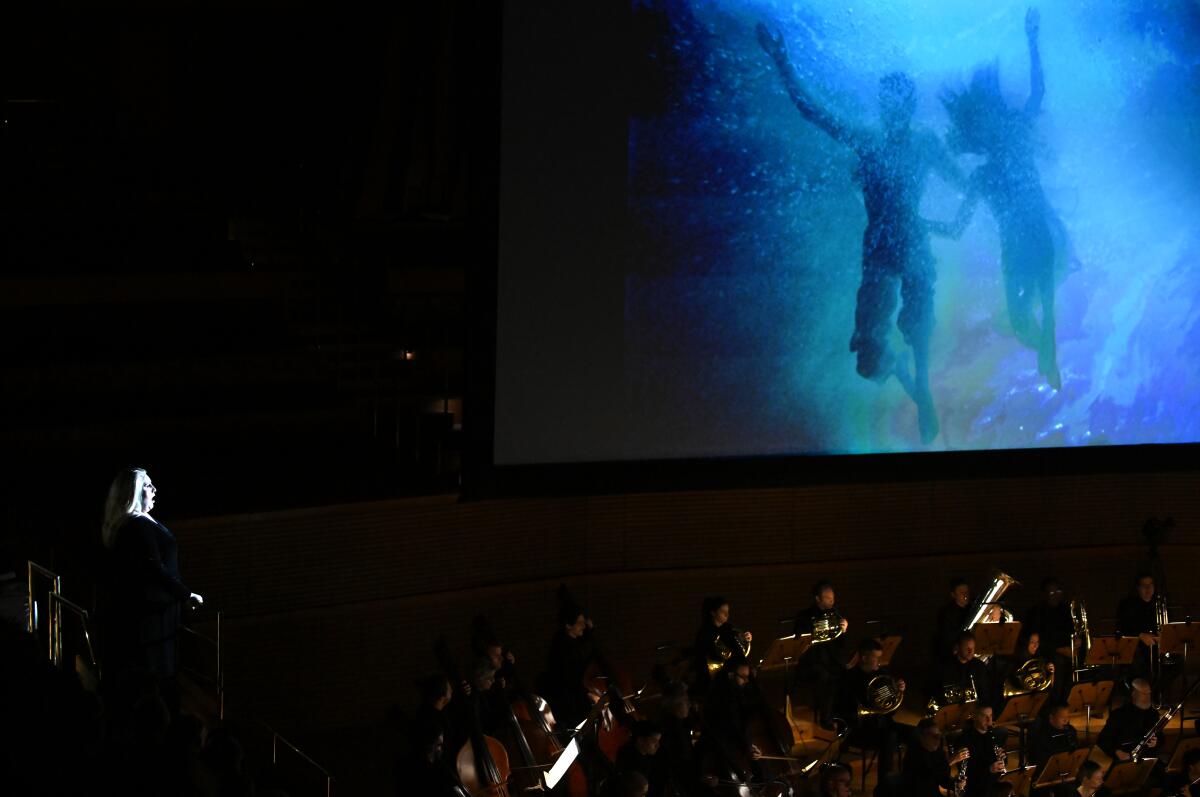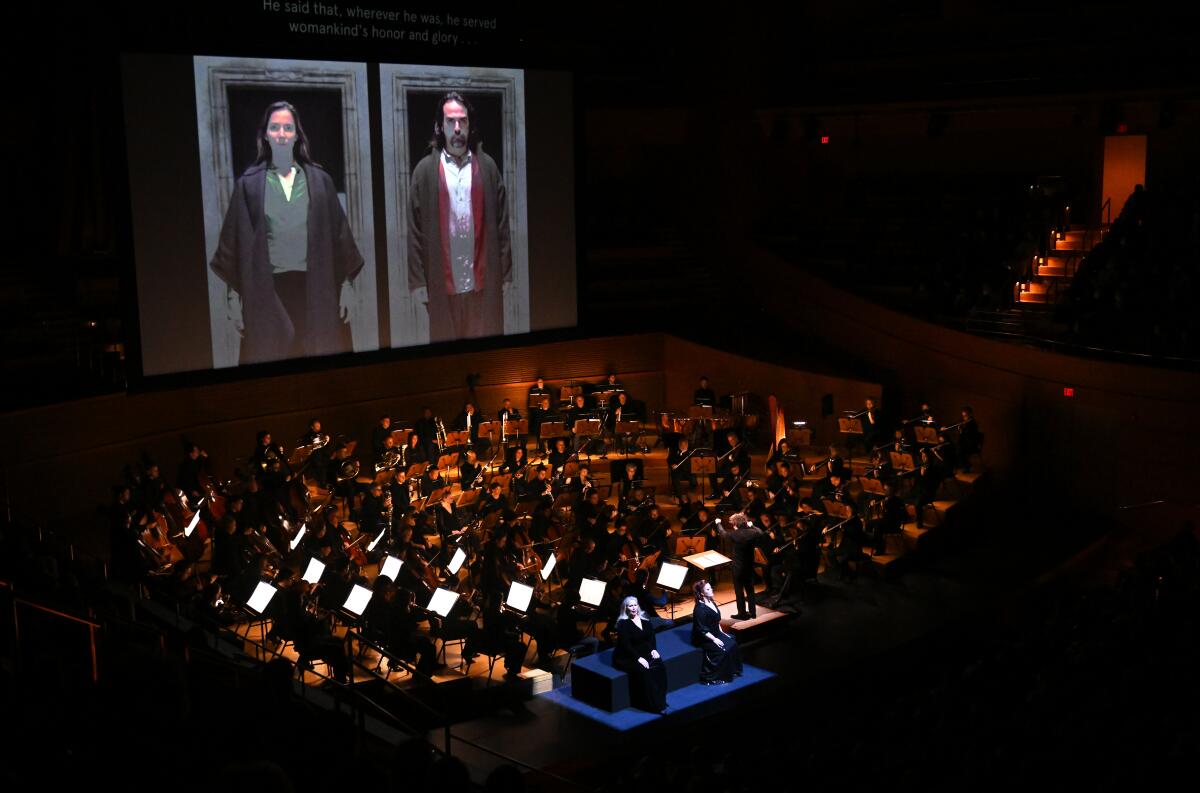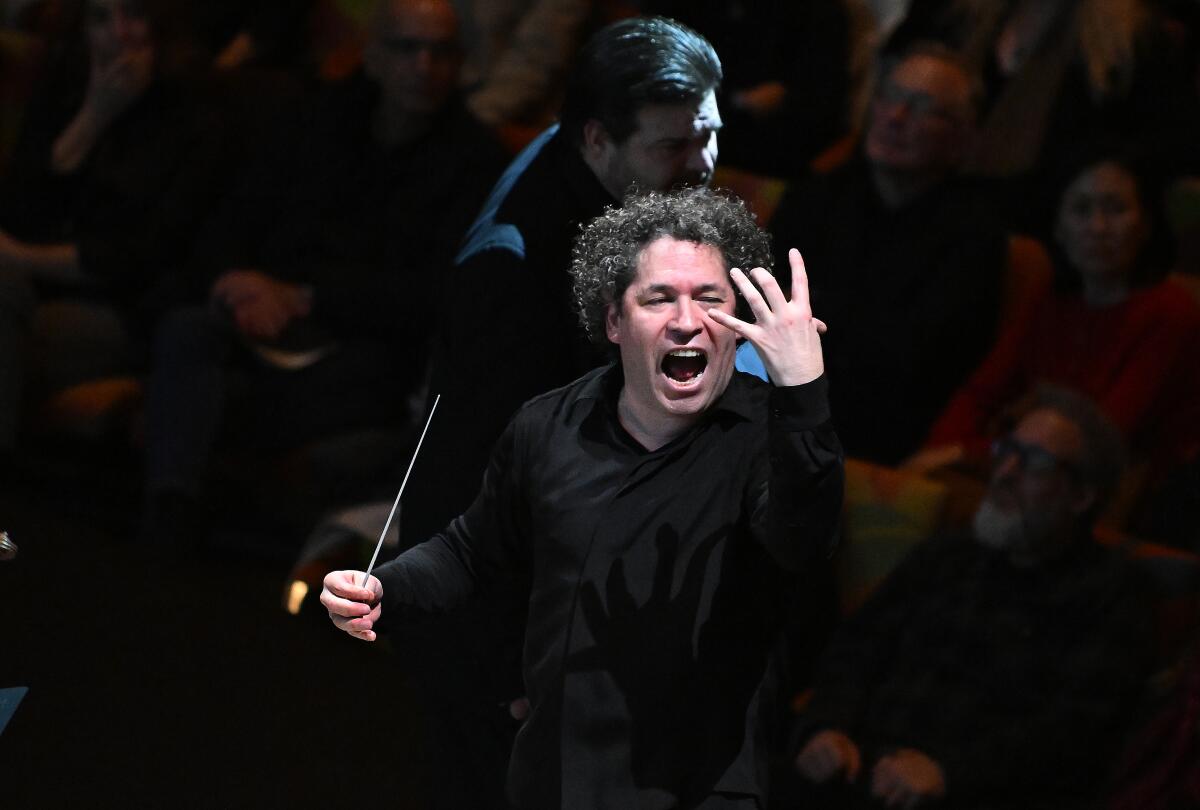Review: The ‘Tristan Project’ is back and more important than ever

“So, let’s drop Dudamel for now,” I suggested in a review of “The Tristan Project” back in 2007, “his time will come.” And, so, it has.
On Easter Sunday 2007, the Los Angeles Philharmonic made the startling announcement that Gustavo Dudamel would succeed Esa-Pekka Salonen as the orchestra’s music director. That had been attention-getting international news, all anyone in music could talk about.
But the following week Salonen happened to be leading the L.A. Phil in a return of what was originally proposed to be a decade-long project he, director Peter Sellars and video artist Bill Viola had mounted to transform Wagner’s “Tristan and Isolde” for a new generation. The “Tristan Project” premiered in 2004 in a transforming new space, Walt Disney Concert Hall, a year after its opening. And it turned out to be a defining moment in nearly 140 years of continual staging of an opera that transformed (and continues to influence) music more than any other single work.
The revolutionary production was, furthermore, a defining moment in the history of the L.A. Phil, and in the history of video art. It was a defining moment for a uniquely L.A. multimedia art created by three of our most significant mid-career artists at the time.
After 15 long years, “The Tristan Project” is back. Now, it belongs to Dudamel.
Salonen originally mounted the opera, an act at a time, accompanied by a work from the 20th century that was in dialogue with Wagner. Dudamel followed that format last weekend (with a three-night repeat beginning Thursday) but without other music.
Instead, Dudamel is intermixing full regular concerts as well as Saturday morning children’s versions with exuberantly performed excerpts from Tchaikovsky’s “The Nutcracker,” along with Duke Ellington arrangements given sensational swing. Wagner isn’t as far away as he might seem. Tchaikovsky had, like so many artists of his time and since, an obsession (be it love or hate or some vexatious combination of both) with “Tristan.”
For his part, Dudamel is all in for “Tristan.” This is his first time conducting an opera that he has long been obsessed with, and the circumstances of doing it with Sellars’ staging and Viola’s videos in Disney is literally a trial by fire and water.
The non-narrative videos, which may well come to be regarded as the Sistine Chapel of video art, projected onto epic screens above the orchestra and singers, serve not to illumine Wagner’s drama but his intent. As Sellars explained in the Upbeat Live preconcert talks, Viola’s cameras aren’t focused on what we see but what is behind what we see.
Tristan and Isolde share a love, artificial (a love potion confounds enemies) yet so deep it grows beyond the capacity of earthly existence. Wagner’s endless melody, his harmonic opacity, incomparably takes us there. The there is where Viola comes in. He offers in the first act a ritual — a solemn couple with Wagnerian slowness and certainty undress to prepare for a journey.

In Act 2, epic visions of bursting flames and floods seem as though they could leap from the screen and envelop the orchestra, singers and the senses of all who watch and listen as ecstasy produces enlightenment. In their deaths, they‘re beyond the elements of earth, water, fire and air, beyond identity and consciousness, and enter into multidimensional space.
Frank Gehry’s ship-like interior of Disney then becomes an actual operatic vessel for this mystic voyage through a sea of eros that defies reality. The setting itself is minimal, a bench covered in black is the only stage property. The singers are all in black. They come at you from all angles — onstage, on high and on the side balconies, in the back of the hall. Yet for them there is only intimacy, only them, no outside world, each in their own pain and finding their own promise.
Dudamel brings a heavy physicality to all this that is very different from Salonen’s more transparent approach. Every emotion is brought out. If Viola presents the rough sea as a metaphor for the turmoil splashing inside us, Dudamel situates us directly on the sea-sickening sea. When Viola unleashes his spectacular fire, you burn. When the angels take us aloft, you glide upward on angels’ wings. The orchestra could sound a little unsteady at times (rehearsal for an orchestra on a weekly concert schedule for a four-hour opera is a fraction of what it is for an opera company putting on a production that will run weeks), but it remained ever alive to the moment, be that in the most desolate of solos or passionate of climaxes. When it matters the most, this is playing to take your breath away.

There was little emphasis on vocal beauty, though, this time around, almost as if that might somehow distract from the profound searching at hand. Swedish tenor Michael Weinius, a secure and crisply articulated Tristan capable of enunciating every word, is movingly stripped, bit by bit, of all his ego armor. Miina-Liisa Värelä, a soprano from Finland with a buttery voice, offered a slightly understated Isolde, less able to cut through the orchestra. But despite an announcement before the second act that she was under the weather, she nonetheless remained in firm control and sang her transporting “Liebestod” at the end with a grace that accompanied the transcendent video of soul liberated from body.
The secondary roles proved especially strong, and, in Sellars’ interpretation, became characters as embroiled in Wagner’s agonizing consciousness-raising as were the lovers. Tristan and King Marke, whom the unfaithful Tristan betrays, are here shown to have been lovers, and Eric Owens’ Marke is an unforgettable portrait of pathos. Meanwhile, Okka von der Damerau as Isolde’s faithful servant, Brangäne, embodies a rich compassion. Ryan Speedo Green’s Kurwenal, Tristan’s warrior servant, adds a consequential depth of fury. The Los Angeles Master Chorale thrillingly ends the first act.
Ultimately, however, what makes the “Tristan Project” different this time around is not how much it has changed, but how much we have.
The production stands as a corrective to the current fad for cheesy commercial immersive art. Wagner envisioned a Gesamtkunstwerk, an all-inclusive art of music and drama and visuals that he never had the means to actually realize. Here is the real thing, where video liberates rather than imprisons all-enveloping music. The production also maintains the kind of deep spiritual ambition that has lost favor, replaced more often than not by something closer to modern-dress dysfunction that you might find on a Netflix flick.
L.A. has changed as well in the past 18 years. Optimism has lessened. We fear fire and water as inevitable climate-change agents of destruction. We separate ourselves as rich and poor, housed and unhoused, and live with many other divisions. We shrink from grand social and environmental solutions as being too expensive, too impractical, too imaginative. We embrace a digital realm (in which everything is reduced to ones and zeros) that stands for existence as blind Tristans and Isoldes nursing their bruised individual egos before seeing the light. The dualities of love and hate, life and death, dissolve at Disney, making imagining beyond the predicable possible.
A generation from its creation, this “Project,” which can help serve to guide the next generation, is happily in excellent hands. May we pay heed.
'The Tristan Project'
What: Gustavo Dudamel conducts “The Tristan Project”
When: 8 p.m. Thursday, Friday and Saturday at Walt Disney Concert Hall
Tickets: $64 - $216
Info: (323) 850-2000, laphil.com
More to Read
The biggest entertainment stories
Get our big stories about Hollywood, film, television, music, arts, culture and more right in your inbox as soon as they publish.
You may occasionally receive promotional content from the Los Angeles Times.











